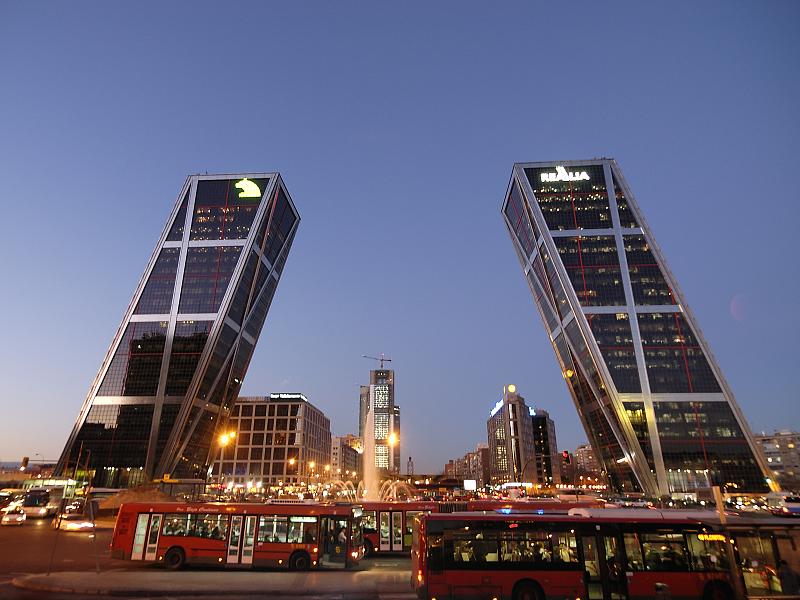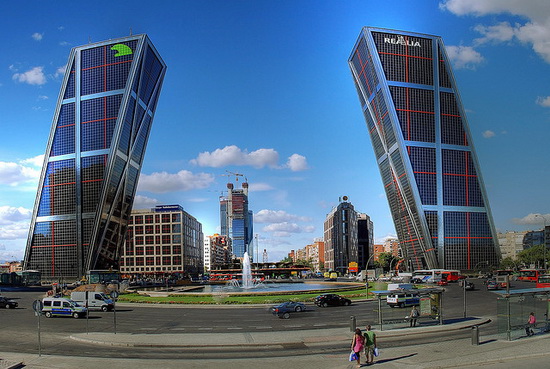Gate of Europe
The Gate of Europe towers are twin office buildings located in Madrid, Spain. When they were completed in 1996 they were the world’s first inclined high-rise buildings.
American architects Philip Johnson and John Burgee had to come up with a solution to a complex site on one of Madrid’s most important boulevards, the Paseo de la Castellana. A significant setback from the street was required in order to clear a subway interchange.
The resulting structural expressionistic towers are 114 m (374 ft) tall, with an inclination of 15º. They stretch 30 m from their base over the boulevard.
The structural solution involved a 60x10x10 m concrete counterweight located on the opposite side of the inclination under the ground and connected to the top of the tower by cable. This provided the necessary counteraction to the overturning forces.
The building is further strengthened by a primary diagrid of structural steel at the buildings’ perimeters, and a reinforced central core housing the main vertical circulation. Lateral stability is provided by secondary horizontal and vertical structural steel members, expressed architecturally on the facades.
The structure is clad with stainless steel and a dark, reflective curtain wall. The secondary horizontal and vertical members are picked out in red .
The towers are differentiated by the colour of their roof helipads – the west tower’s is blue, the east tower’s is red.
[edit] Related articles on Designing Buildings Wiki
Featured articles and news
RTPI leader to become new CIOB Chief Executive Officer
Dr Victoria Hills MRTPI, FICE to take over after Caroline Gumble’s departure.
Social and affordable housing, a long term plan for delivery
The “Delivering a Decade of Renewal for Social and Affordable Housing” strategy sets out future path.
A change to adoptive architecture
Effects of global weather warming on architectural detailing, material choice and human interaction.
The proposed publicly owned and backed subsidiary of Homes England, to facilitate new homes.
How big is the problem and what can we do to mitigate the effects?
Overheating guidance and tools for building designers
A number of cool guides to help with the heat.
The UK's Modern Industrial Strategy: A 10 year plan
Previous consultation criticism, current key elements and general support with some persisting reservations.
Building Safety Regulator reforms
New roles, new staff and a new fast track service pave the way for a single construction regulator.
Architectural Technologist CPDs and Communications
CIAT CPD… and how you can do it!
Cooling centres and cool spaces
Managing extreme heat in cities by directing the public to places for heat stress relief and water sources.
Winter gardens: A brief history and warm variations
Extending the season with glass in different forms and terms.
Restoring Great Yarmouth's Winter Gardens
Transforming one of the least sustainable constructions imaginable.
Construction Skills Mission Board launch sector drive
Newly formed government and industry collaboration set strategy for recruiting an additional 100,000 construction workers a year.
New Architects Code comes into effect in September 2025
ARB Architects Code of Conduct and Practice available with ongoing consultation regarding guidance.
Welsh Skills Body (Medr) launches ambitious plan
The new skills body brings together funding and regulation of tertiary education and research for the devolved nation.
Paul Gandy FCIOB announced as next CIOB President
Former Tilbury Douglas CEO takes helm.
UK Infrastructure: A 10 Year Strategy. In brief with reactions
With the National Infrastructure and Service Transformation Authority (NISTA).
























